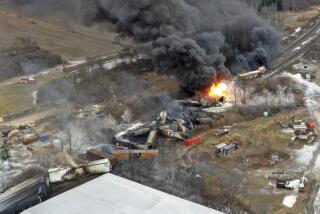Land Mines Have Strategic Value
President Clinton’s recent decision to support the Canadian Ottawa process signals a disturbing change in the administration’s land mine policy that may leave American soldiers vulnerable.
The Ottawa process is a series of talks, involving more than 100 countries, aimed at a universal ban on land mines. Supporters hope to have a treaty in place by the end of this year. In the past, the United States has been involved in U.N. discussions not to outlaw mines, but to limit their use. China and Russia also were involved in the U.N. talks but have been conspicuously absent from the Ottawa talks.
Unquestionably, land mines have a grisly legacy. Each month, mines kill nearly 800 people and wound 450. Of the 1 million land mine victims during the past 20 years, eight out of 10 were noncombatants, often stumbling upon the mines years after the cessation of hostilities. At present, 100 million land mines in more than 60 countries lie waiting to be cleared or to destroy some unsuspecting victim. That figures out to about one hidden mine for every 50 people on earth. In the 12 countries with the worst land mine problems, one mine has been laid for every three to five people.
Despite the horrific catastrophe created by land mines, a worldwide ban cannot succeed. Land mines are simply too easy and too cheap to manufacture--$2 to $10 each. But the cost of removing a mine can reach as much as $1,000. Clearing the world’s 120 million mines would cost more than $100 billion.
Many of the world’s mines were laid with the goal of depleting the other side’s resources by maiming rather than killing the enemy. The cost of caring for an amputee is far more extensive than just putting a soldier in a body bag and shipping him home. Not only does the care cost in dollars, but also in manpower and public sentiment.
Thus, mines have become the poor man’s weapon of choice. In times of conflict, poor countries and struggling insurgents will continue to turn to the mine as a low cost, high return investment. Historically, guerrilla factions and rogue nations such as Iraq and Angola have blatantly disregarded the land mines protocol of the Geneva Convention. Is there reason to presume that they will honor an out-and-out ban? Forget trying to cut off the supply, they will make the mines themselves. An estimated 25% of the 2 million to 3 million mines currently deployed in the Balkans are homemade. A ban would result in mines left in the hands of the bad guys, and our soldiers with their hands tied.
Land mines are still a legitimate component of the U.S. military arsenal. Current U.S. military doctrine regards mines as a military necessity. They are “combat multipliers,” said to “shape the terrain,” giving the military the ability to channel enemy forces into a specific sector or to scatter forces over a broad zone. The U.S. has taken every precaution to minimize civilian casualties. Except for the demilitarized zone between North and South Korea, the U.S. employs only self-destructing or self-neutralizing mines, which perform inaccurately only .0031% of the time, making the advent of a hazardous dud extremely rare. Furthermore, these “smart” mines are aimed only at valid targets (enemy soldiers) with the goal of saving U.S. soldiers’ lives.
Most recently, mines prevented U.S. casualties during the Gulf War. Mine fields sown by the U.S. Air Force halted two Iraqi divisions as they attempted to attack the vulnerable left flank of the advancing U.S. ground forces. As long as military leaders are able to point to this type of example, a complete ban on land mines will be unwelcome. Enforcing the correct employment of land mines, rather than a wholesale ban, is the key to making the world safer.
More to Read
Sign up for Essential California
The most important California stories and recommendations in your inbox every morning.
You may occasionally receive promotional content from the Los Angeles Times.










